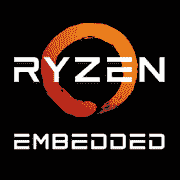AMD Ryzen Embedded V1202B

AMD Ryzen Embedded V1202B: Compact Power for Niche Tasks
April 2025
Key Features: Zen Architecture in Miniature
The AMD Ryzen Embedded V1202B processor is an embedded solution based on the first-generation Zen microarchitecture (2017), built on a 14nm process. Despite the architecture's age, the chip remains relevant thanks to optimizations for low-power tasks.
- Cores and Threads: 2 cores / 4 threads. Suitable for light multitasking, but not for resource-intensive computations.
- Cache: 2 MB L3 — a modest size typical for budget models.
- Graphics: Radeon Vega 3 (192 shader processors) — capable of handling 4K video and basic 3D graphics.
- TDP: 15 W — allows for passive cooling or a compact cooler.
- Performance: Geekbench 6 — 860 (single-core), 1578 (multi-core). For comparison, the Intel Celeron G6900 (2 cores/2 threads) scores around ~950/1800 but consumes 46 W.
Key Feature — embedded design. The processor is intended for systems where reliability, long lifespan (up to 10 years of support), and operation in extreme conditions (temperatures from -40°C to +105°C) are essential.
Compatible Motherboards: Miniature and Specialized
The V1202B uses the FP5 socket, characteristic of AMD’s embedded solutions.
- Chipsets: Typically, these are specialized solutions like the AMD XR1 or partner boards with customized chips.
- Form Factors: Mini-ITX, Nano-ITX, as well as boards for industrial controllers (e.g., from Kontron or Advantech).
- Examples:
- ASRock IMB-V1202B (Mini-ITX, 2x HDMI, 4x USB 3.2, price ~$180).
- Kontron SMARC-sAMR5 (module for embedded systems, price starting at $250).
Important: When choosing a motherboard, check for interface support (e.g., HDMI 2.0 for 4K@60Hz) and the presence of industrial connectors (COM ports, GPIO).
Memory: DDR4 with a Focus on Stability
The processor supports DDR4-2400 MHz in dual-channel mode.
- Recommendations:
- For embedded systems, choose modules with ECC (e.g., Kingston ValueRAM 8GB DDR4-2400 ECC, ~$45).
- Maximum capacity is 32 GB (2x16 GB), but for most scenarios, 8-16 GB is sufficient.
- DDR5 is not supported — this is a conscious decision by AMD to reduce costs and ensure compatibility with industrial boards.
Power Supply: Minimum Watts, Maximum Reliability
With a TDP of 15 W, a system based on the V1202B consumes no more than 40-60 W (considering storage and peripherals).
- Recommendations:
- Without discrete graphics: Power supplies from 150-200 W (e.g., Seasonic SSP-200ES, ~$50).
- For passive systems: PicoPSU (for example, 120 W with an external adapter, ~$80).
- Industrial solutions: Power supplies from Mean Well (RPS series, ~$60-100) featuring surge protection.
Pros and Cons: Who is V1202B Ideal For, and Who Should Look for Alternatives
Pros:
- Energy efficiency: Ideal for 24/7 operation (e.g., digital signage).
- Vega 3 Graphics: Handles 4K streaming and light gaming (Minecraft, Stardew Valley).
- Long support: A 10-year warranty is crucial for industrial projects.
Cons:
- Weak multi-threaded performance: Lags behind modern 4-core APUs.
- Limited upgradeability: The FP5 socket is incompatible with newer Ryzen generations.
- Price: $120-150 for the processor — somewhat steep for a home media center.
Use Cases: Where the V1202B Shines
1. Industrial PCs: Machine control, IoT gateways (e.g., Advantech warehouse monitoring system based on V1202B).
2. Media Centers: 4K HDR via Kodi or Plex (connection to a TV via HDMI 2.0).
3. Office Tasks: Document work, browser, Zoom — easily sufficient.
4. Light Gaming:
- Dota 2 on low settings: ~40 FPS at 720p.
- Emulation (PSP, PS2): DuckStation handles 60 FPS.
Comparison with Competitors: Budget Battle
- Intel Celeron J6412 (4 cores, 10 W, UHD Graphics):
- Pros: Better in multi-threading (~1700 in Geekbench 6 Multi).
- Cons: Weaker graphics than Vega 3. Price ~$130.
- NVIDIA Jetson Nano:
- Pros: Optimized for AI tasks, 128 CUDA cores.
- Cons: No x86 compatibility, more complex software situations.
Conclusion: The V1202B wins in versatility (x86 + graphics) but loses to specialized chips.
Assembly Tips: Compactness and Reliability
1. Case: Opt for passive solutions (e.g., Streacom F1C WS, ~$90).
2. Storage: M.2 NVMe 256 GB (e.g., WD Red SN700, ~$40) — fast and reliable.
3. Cooling: Even the built-in heatsink will suffice, but for hot environments, add a 40mm fan (Noctua NF-A4x10, ~$15).
4. Networking: If 2.5G Ethernet is needed, use a PCIe adapter (e.g., TP-Link TX201, ~$25).
Final Conclusion: Who is the Ryzen Embedded V1202B Suitable For?
This processor is designed for niche yet important tasks:
- Industrial system integrators: Where stability and long support are needed.
- Compact PC enthusiasts: For a quiet media center or mini-server.
- Educational projects: Affordable computers for schools or laboratories.
Price: $120-150 for the processor (new) is justified for the corporate sector, but there are more cost-effective options for home use (e.g., Ryzen 3 5300U).
If you need a "workhorse" for light tasks, with the potential for 24/7 operation — the V1202B is an excellent choice. For gaming or rendering, look for something more powerful.
Basic
CPU Specifications
Memory Specifications
GPU Specifications
Benchmarks
Compared to Other CPU
Share in social media
Or Link To Us
<a href="https://cputronic.com/en/cpu/amd-ryzen-embedded-v1202b" target="_blank">AMD Ryzen Embedded V1202B</a>